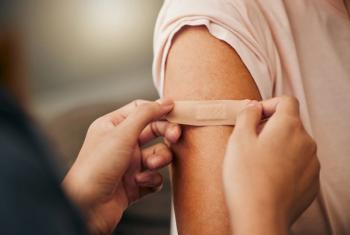
BEHAVIOR: ASK THE EXPERTS
BEHAVIOR: ASK THE EXPERTS
GAY PARENTS
QFor the first time in 30 years of office-based practice I nowhave two families where the parents are lesbians. In each case, the coupleparents a daughter. What, if anything, should I know about encouraging optimalchild development in these families? Should I bring up the issue of same-sexparenting at well-child visits or say nothing unless the parents bring upthe subject themselves? Is there any scientific knowledge base here?
Gary M. Gorlick, MD
Los Angeles, CA
A Most children whose parents are gay or lesbian were conceivedthrough a heterosexual relationship. Modern reproductive technologies, includingsperm and egg donation and surrogacy, and the increasing social acceptabilityof homosexuality have led more gay men and lesbians to become parents withinan established same-sex relationship.
The social stigma attached to homosexuality and the resulting secrecyand fear with which these families have had to learn to cope have made systematicresearch into their well-being difficult. Nevertheless, we have ample evidencethat whatever risks to well-being a child encounters because his or herparents are of the same sex are caused primarily by the isolation and discriminationsociety's heterosexism imposes on such families, not difficulties intrinsicto the families themselves. Children whose parents are gay or lesbian haveno more problems with self-esteem, psychological adjustment, intellectualcapacity, academic achievement, or peer relationships than children whoseparents are heterosexual.
Some data suggest that children of same-sex parents are more acceptingof differences and disabilities in others and more nurturing in relationshipswith their peers than children from more traditional families. The riskof physical or sexual abuse is lower in families whose parents are of thesame sex than in heterosexual families. While data about adults who wereraised by same-sex couples are limited, the available evidence suggeststhat their psychosexual development is similar to that of adults who wereraised in traditional families.
You can help the lesbian parents and their children in your practiceby creating an environment of acceptance and support where these familiescan feel comfortable talking about their particular unit, its strengthsand its difficulties. Such acceptance can be indicated in small ways--bychanging the designation "mother and father" on office forms to"parents," by displaying some visible symbol, such as a pink triangleor rainbow symbol, or by posting information about community support groupsand national resources for gay men and lesbians. I suggest inquiring aboutfamily circumstances in a way that invites parents to initiate a conversation.Try asking, "How do you divide the parenting tasks?" or "Arethere discipline issues the two of you don't agree about?"
Some periods are predictably rough for children of same-sex parents--whenchildren question their own conception and birth, first in the preschoolperiod and later in early adolescence as they attempt to understand theirgenetic identity, for example. When children begin school may also be adifficult time since their family structure may prove a stigma, leadingto criticism and even socialisolation.
Pediatricians can be helpful resources for parents who are thinking aboutand addressing these issues with their children. As always, counsel parentsto be as honest with their children as the family and community environmentallow. Books addressing areas of concern to these special families havebeen published both for parents and for children. Family Pride Coalitionis a national group of gay and lesbian parents; it can be reached at POBox 34337, San Diego, CA 92163, 619-296-0199, or
Most families are grateful for an opportunity to have an honest and openrelationship with their pediatrician, but may need to be reassured thatthey are not jeopardizing their own well-being or that of the child in lettingtheir family situation be better known.
Ellen C. Perrin, MD
Worcester, MA
DR. PERRIN is Professor of Pediatrics, University of Massachusetts MedicalCenter, Worcester, MA.
CHILDREN WHO PICK SCABS
QI have several patients who habitually pick at scabs of wounds,preventing them from healing completely and sometimes reopening the wound.This results in unsightly scars. I have tried adhesive bandages, clear bio-occlusivetape, and even Steri-strips, but the children always peel them off. In addition,moms are unhappy with this approach because it seems to call more attentionto the area. Any suggestions about how to stop the picking?
Justina Breseno, MD
Ho-Ho-Kus, NJ
AThe problem of scab picking is difficult for parents and physiciansto understand and manage. Like many common questions, it has not been wellstudied.
Contributing factors to consider are stresses and emotional problemsand topical irritants and oral medications, such as stimulants, that mayinduce itchiness. The repertory of management techniques is limited:
* Attempt to prevent the lesions that become scabbed
* Address any emotional issues that may be prompting the picking, includingthose that relate to parent-child conflict or motivation
* Use an occlusive dressing
* In severe cases, consider using a procedure called habit reversal.
Habit reversal has three components: increasing the individual's awarenessof the habit; teaching a competing response to the impulse to practice thehabit; and sustaining compliance and facilitating generalization of thealternative response. To perform this training, you will probably need thehelp of an appropriately trained psychologist. For more on this subjectand the habit reversal procedure, see the chapter on repetitive behaviorby Dr. Nathan J. Blum in the third edition of Developmental-Behavioral Pediatrics(WB Saunders Co, 1999).
William B. Carey, MD
Philadelphia, PA
DR. CAREY is Clinical Professor of Pediatrics, University of PennsylvaniaSchool of Medicine,
and Director of Behavioral Pediatrics, Division of General Pediatrics, Children'sHospital of Philadelphia.
OCD IN A NEW GUISE
QA grandmother of an 8-year-old girl called to tell me that hergranddaughter suddenly began showing some unusual behaviors--excessive handwashing, bizarre concerns about the safety and purity of foods, and an insistenceon eating only with paper plates and disposable silverware. She began actingthis way shortly after having a sore throat. The grandmother had recentlyread about PANDAS (pediatric autoimmune neuropsychiatric disorders associatedwith streptococcal infections) and wondered if this could be the diagnosis.Do you think she is onto something? And what is the best way to deal withthis child?
Marc Wager, MD
New Rochelle, NY
A In the good old days, we would have leisurely read about PANDASfor a few years before even discussing it with a parent. Now families approachus with the latest (premature, unresolved, unproved) theories from the Internetbefore we've even heard of them. It's a real quandary: How do we deal withhot-off-the-press information in a responsive yet responsible way?
PANDAS has been described in only about 10 articles. The idea is thatgroup A b-hemolytic streptococcal infections set up an autoimmune responsethat alters specific parts of the brain, such as the basal ganglia. Symptoms,which wax and wane, begin at about 7 years of age (standard deviation, threeyears) and can include obsessive compulsive disorder (OCD), tics, emotionallability, fears, separation anxiety, cognitive deficits, oppositional behaviors,and hyperactivity. One study postulates a genetic predisposition in affectedpatients. Immunologic modifying treatments, such as plasmapheresis, intravenousimmunoglobulin, or prednisone, are being tried, apparently with some success.
This is a fascinating area, but clearly the returns aren't in. Do youdare to suggest any of these treatments for this little girl? Should yourefer her to an expert on PANDAS in the New York area? If I were in yourshoes, I'd first do no harm and wait for a lot more data before initiatingany sort of work-up or treatment for possible PANDAS. On the other hand,this child needs a mental health referral for standard evaluation and treatmentof OCD--with sertraline--as soon as possible.
Steven Parker, MD
Boston, MA
DR. PARKER is Director, Division of Developmental and Behavioral Pediatrics,Boston City Hospital,
and Associate Professor, Department of Pediatrics, Boston University Schoolof Medicine.
TODDLER WON'T SLEEP THROUGH NIGHT
QI have in my practice an active, sociable, 26-month-old who hasnever slept through the night. His mother says he awakens at midnight or1 a.m. and wants to play or watch TV until 4 or 5 a.m. I suggested she "safetyproof" his room and set up a gate to confine him and allow him to playby himself at night, but he climbs the gate or screams until someone comes.The child takes one nap during the day for 45 minutes to an hour.
Whitney Lutz, CPNP, RN
Grapevine, TX
A Research shows that neither "crying it out" nor medicationmakes much of a difference with the type of child you describe. In addition,most parents have a tough time letting the child cry it out, and whateverbenefits the medication achieves usually are lost when it is discontinued.
Like many toddlers, this boy may simply lack self-quieting skills orhas never really been allowed to use the skills he does have. The processof helping him to develop these skills and to use them to go to sleep takesfrom one to three weeks. The parents begin by greatly increasing the amountof nonverbal physical contact they give the child--at least 100 brief (threeto four seconds) nonverbal, physical touches each day. By giving these toucheswhen the child is not fussing or crying, the toddler does not lose whatevergain he may be getting from fussing; instead this gain is shifted to timeswhen the toddler is pleasant and fun to be around. Equally important, theparent should get the toddler up every morning at the same time and be surehe gets a lot of physical exercise throughout the day, by walking in thepark or, in bad weather in a shopping center, for example.
After about one week of showering the boy with additional physical contact,the parent should allow the child to calm himself on one occasion duringthe day when he seems upset. If he starts fussing when his blocks fall over,for example, she should leave him alone until he is calm for three to fourseconds before comforting him. It is critical that the child have the experienceof calming himself before the parent intervenes.
This exercise may be difficult for the parent the first few times shetries it. By teaching these self-quieting skills during the day, however,the parent is reassured that nothing is wrong with the toddler when he criesand she can be comfortable letting him comfort himself at night. She shoulddo so only after the child has calmed himself at least 40 to 50 times duringthe day.
Edward T. Christophersen, PhD
Kansas City, MO
DR. CHRISTOPHERSEN is Professor of Pediatrics at The Children's MercyHospital.
WE NEED YOUR HELP!
You like "Behavior: Ask the experts." We know because you'vetold us in reader surveys. In addition, our mail bag is full of your commentson our experts' responses to submitted questions. But we need more of thesequeries to keep this department running smoothly--or running at all. Pleasethink about the most interesting or difficult behavioral or developmentalissues that have come up in your practice in recent weeks and write us aboutthem.
We'll be grateful, other readers will be grateful, and you'll get some
good advice about your patient.
Send your question by mail, fax, or E-mail to:
Behavior Q/A
Contemporary Pediatrics
5 Paragon Drive
Montvale, NJ 07645-1742
(fax):201-358-7260
To be considered for publication, a letter must be signed.
(Sorry, but queries cannot be answered individually.)
Newsletter
Access practical, evidence-based guidance to support better care for our youngest patients. Join our email list for the latest clinical updates.









